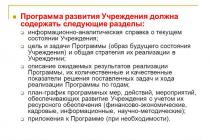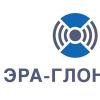Preview:
To use presentation previews, create a Google account and log in to it: https://accounts.google.com
Slide captions:
OO development program as a vector for updating the activities of an educational organization
The structure of the PA development program, described in the recommendations valid until 2016. The structure recommended by the Federal Center for Education and Defense for 2016 - 2020.
What is an educational order (standard) imposed on the activities of an educational institution, recorded in regulatory documents? What is the model of an educational institution in the content of legislative documents, including regulations? Opportunities for the development of OO?
To develop an Educational Institution Development Program, it is necessary to consistently answer the following questions: What do we want to change? What are students dissatisfied with in their educational results? Goal What do we want to achieve and through what changes in the educational process and educational environment? Key project idea What do we have for this and what will be required? SWOT analysis of strengths and weaknesses How will we change this? What do we do? Proposed management model of change and step-by-step plan How will we evaluate the achievement of our goals? Measurable criteria and indicators for diagnosing new educational results of students, assessing teacher performance, and implementing the educational process. What can prevent us from achieving our goals? How can this be prevented? Risks and measures to minimize them What financial resources will be required to implement the Development Program? Financial plan
The main stages of development of the Development Program and expected results (the basis of the “road map”) Stages of making management decisions when developing a development program for a public organization
Program Passport Characteristics of the problems that the Program is aimed at solving. The main goals and objectives of the Program, terms and stages of its implementation, a list of target indicators and indicators reflecting the progress of its implementation. Activities of the Program and complex projects that ensure the implementation of the objectives of the Program Justification of the resource provision of the Program Mechanism for implementing the Program Assessment of the socio-economic effectiveness of the Program
Requirements for the development program of public organizations and ways to ensure them
Thank you for your attention!
Characteristics of the problems that the Program is aimed at solving. REQUIREMENTS POSSIBILITY of contradictions ANALYSIS compliance of PA activities with the goals of state policy identification of reasons that reduce efficiency identification of discrepancies between the results of PA activities and expectations of the external environment
SWOT - strategy External environment Opportunities (O) Threats (T) Internal environment Strengths (S) I. Development strategy II. Experimental Strategy Weaknesses (W) III. Compensation strategy IV. Defense strategy
PRIORITIES OF STATE POLICY IN THE FIELD OF EDUCATION State program of the Russian Federation "Development of education" for 2013-2020 Federal target program for the development of education for 2016-2020 State program of the Republic of Sakha (Yakutia) "Development of education of the Republic of Sakha (Yakutia) for 2012 - 2019"
The main goals and objectives of the Program, terms and stages of its implementation, a list of target indicators and indicators reflecting the progress of its implementation. School development strategy. Goal and objectives of the development program Timing and stages of program implementation Indicators and indicators reflecting the progress of the program
The goal of the development program ……….. To achieve this goal, we will highlight the directions of the development program and define tasks for each direction: Direction “…………” Task 1 ….. Task 2 ….. Direction “…………” Task 1 … .. Task 2…..
Activities of the Program and complex projects that ensure the implementation of the objectives of the Program Project structure: key problems, design, social effect, goal and objectives, stages, calendar plan of activities, evaluation criteria and tools, financing, control body.
Justification of resource support for the Program Table of target indicators of state programs in the field of general education Possible activities (projects)
Assessment of the socio-economic effectiveness of the Program effectiveness The relationship of the results to..... the values of modern education, the needs of the child, society, the economy, the goals set for him by the state educational policy, and the costs
Preview:
OO development program as a vector for updating the activities of an educational organization"
Drobot N.V., Deputy Director for HR
MBOU Secondary School No. 5 (Moscow Municipality "Aldan District")
RS (I)
The current situation in the Russian education system can be characterized as entering a period of constant changes in educational and management practices.
The changes taking place are consolidated in legislation and the regulatory framework.
In particular, in accordance with Art. 28 part 3 clause 7 of the Federal Law of December 29, 2012 No. 273-FZ “On Education in the Russian Federation” “toThe competencies of an educational organization in the established field of activity include ... development and approval, in agreement with the founder, of a development program for an educational organization...».
Every beginning (and not only beginners) modern head of an educational organization faces many questions related to this competence. Such issues, in particular, include the following:
- What is the Public Education Development Program within the framework of modern state policy in the field of education and science? What is its structure?
- Are there common approaches in the practice of developing development programs in the logic of implementing the state educational policy of the Russian Federation in the field of education?
- And etc.
The NGO development program is a product of collective creativity and is not subject to regulation. Thus, it is impossible to put forward strict standards and requirements for its structure. However, accumulated management knowledge allows us to identify several components of the development program, which to one degree or another should be inherent in it.
The Federal Target Program for the Development of Education for 2016 - 2020 (approved by Decree of the Government of the Russian Federation dated May 23, 2015 No. 497 (as amended on September 14, 2016) proposes a different structure for the Development Program.
Let’s compile a comparative table of the structure of the Development Program described in the recommendations valid until 2016 and the structure recommended in the Federal Target Program for Education Development for 2016–2020:
The structure of the NGO development program, described in the recommendations valid until 2016 | |
|
|
Section 1. Characteristics of the problems that the development program is aimed at solving. | |
Section 2. The main goals and objectives of the target program, terms and stages of its implementation, a list of indicators and indicators reflecting the progress of its implementation. |
|
Section 3. Development program activities. |
|
Section 4. Description of program resources. |
|
Section 5. Assessing the effectiveness of the target program (expected results of the program and target indicators - measurable quantitative indicators of solving the assigned tasks and the progress of the program by year. |
|
Thus, in the current situation of institutional transformations in the activities of an educational institution, the Program for its development should be in the form of a project-target program.
Designing a development program for an educational organization on the basis of the Law “On Education in the Russian Federation” begins with the differentiation of the educational program and the development program itself.
In turn, the Development Program of an educational institution describes changes in the infrastructure of educational institutions that ensure the implementation of the educational program. This separation makes it possible not to mix in the content of one document components related to different aspects of the educational activities of public organizations (Fig. 1).
Currently, the social environment considers an educational organization as a condition and/or a tool for fulfilling its educational task, therefore requirements are placed on educational institutions as an instrument - to best comply with the performance of the intended function. This is especially noticeable in the context of the transition to federal state educational standards (hereinafter referred to as Federal State Educational Standards), which can be considered as a state task, i.e. system of requirements for an educational institution.
Thus, when starting to analyze the development opportunities of an educational institution, it is necessary to answer the questions:
- What is an educational order (standard) imposed on the activities of an educational institution, recorded in regulatory documents?
- What is the model of an educational institution in the content of legislative documents, including regulations?
To develop a Development ProgramAn educational institution must consistently answer the following questions:
- What do we want to change? What is not satisfactory about the educational results students receive? ( Target ).
- What do we want to achieve and through what changes in the educational process and educational environment? (Key project idea).
- What do we have for this and what will it take? (SWOT analysis of strengths and weaknesses - available and missing resources).
- How are we going to change this? What do we do? (Proposed management model of change and step-by-step plan).
- How will we evaluate the achievement of our goals? (Measurable criteria and indicators for diagnosing new educational results of students, assessing teacher performance, and implementing the educational process).
- What can stop us from achieving our goals? How can this be prevented? (Risks and measures to minimize them).
- What financial resources will be required to implement the Development Program? ( Financial plan ).
From a management point of view, the Program is the basis for making operational management decisions in the daily activities of an educational institution.
Actions at each stage of the management decision-making process are presented in the table:
Table 1. Stages of making management decisions when developing a public organization development program
Phase | |
| Monitoring the internal environment of the organization Surveillance of the external environment |
| Description of the problem situation Identifying the organizational unit where the problem arose Problem Statement Assessing its importance Identifying the causes of the problem |
| Defining the organization's goals Formulation of goals for solving a problem |
| Detailed description of the object Determination of the area of change of variable factors Defining Solution Requirements Defining criteria for the effectiveness of a solution Defining Constraints |
| Decomposition of a task into subtasks Searching for solution ideas for each subtask Building models and performing calculations Determination of possible solution options for each subtask and subsystem Summarizing the results for each subtask Forecasting the consequences of decisions for each subtask Development of options for solving the entire problem |
| Analysis of the effectiveness of solution options Assessing the influence of uncontrollable parameters |
| Working out a solution with the performers Aligning the solution with interoperable services Approval of the decision |
| Preparation of a work plan for implementation Implementation of the work plan Making changes to the solution during implementation Evaluating the effectiveness of the adopted and implemented solution |
The main stages of development of the Development Program and expected results (the basis of the “road map”).
Preparatory stage. | Readiness of developers and resources to start working on the program (results). |
|
1.1. | Deciding on the need and timing of program preparation. | Making a decision, formalizing it and communicating it to the entire team. |
1.2. | Creation and launch of a project management system for program development. | Determination and distribution of responsibility for program development, work planning, launching an incentive and control system. |
1.3. | Work to identify, take into account and involve possible partners inside and outside the school. | Expanding the number of program developers and implementers. |
1.4. | Organizing working groups to develop the program, training them and providing them with resources. | Developers are ready to take action. |
1.5. | Preparing the necessary resources and materials, creating conditions for work. | Readiness of conditions and resources. |
1.6. | Search for additional resources, additional training for employees. | Full readiness for work. |
Main stage: the stage of developing the program as a document. | ||
2.1. | Preparation of annotations and introduction to the program. | Abstract and introduction to the program. |
2.2. | Description of objective biographical data about the school: history of the school, current state, statement of the achieved level of development. | Information about the school. |
2.3. | Analysis of the state and forecast of trends in changes in the external environment of the school. | Analysis and forecast data. Conclusions about the living conditions of the school and the influence of the environment on the school in the future. |
2.4. | Analysis of the state and forecast of trends in changes in social orders for schools. | Analysis and forecast data. Conclusions about the original social order. |
2.5. | Analysis of the state and forecast of trends in school resource provision. | Analysis and forecast data. Correlation of the new order and the school’s resource capabilities to implement it. Conclusions about the social order accepted for execution. |
2.6. | Analysis and evaluation of school achievements. | Analysis and evaluation data. A conclusion about the main achievements of the school over the years and the merits underlying them. |
2.7. | Analysis and assessment of the innovative environment and school potential. Forecast of attitude towards changes on the part of school employees and its partners. | Analysis and evaluation data. Conclusions about the possibilities for school development, “points of growth”, about the forces of support for changes in the school and the forces of resistance to the new. Actions of the school leader to expand the support forces for innovations in the school. Expanding the base for successful school development. |
2.8. | Problem analysis of the state of affairs at school. | A system of key problems in school and their causes. |
2.9. | Developing an image of the desired future state of the school and its results. | The concept of the new state of the school as a general desired result of innovative processes in the school. |
2.10. | Development and description of a strategy for the school’s transition to a new state. | Areas, directions, methods, stages and tasks of the school’s transition to a new state. |
2.11. | Specifying the goals for the next stage of school development. | Formulation of goals for the next stage for educational and other subsystems of the school. |
2.12. | Development and description of an action plan for the implementation of program ideas. | A specific and controlled plan of action. |
2.13. | Assembly and initial editing of program text. | Readiness of the first version of the program. |
Stage of examination, summing up and decision making. | Approval of the program and decision-making on the transition to its implementation. |
|
3.1. | Assessment and initial correction of the school development program. | Making changes and amendments to the first version of the text. |
3.2. | Submitting the program for independent external examination, evaluation of the program by experts. | Obtaining opinions from independent external experts, and adjusting the program if necessary based on the results of these opinions. |
3.3. | Informing the team about the progress of work, organizing discussion and approval of the program. | A coherent understanding of the goals of the program and the work to be accomplished. Coordination (approval) of the development program by the state public management body of the school. Acceptance and approval of the program by the school staff. |
3.4. | Submitting the program for approval and official examination. Presentation and advocacy of the program by school leadership. Making decisions about the program. | The final decision on approval of the program and the transition to its implementation, on additional funding and support for the program by governing bodies. |
The developers of the development program independently supplement the presented version of the “road map” with the fields “deadlines” and “responsible (or executors)”.
Program Passport
Passport
Development programs______________________________________________________________
(name of educational institution according to the Charter)
for _________/_________ years
(to be filled in as a table)
Program name | «________________________________________» |
|
Date of the decision to develop the Program (name and number of the relevant regulatory act) | ||
Basis for developing a development program. | The regulatory documents on the basis of which the Program was developed are indicated |
|
Customer of the Program | ||
Main developers of the Program | The development program is developed by the teaching staff of the public organization; the program can be adopted at a meeting of the pedagogical council or the council of the labor collective (in accordance with the Charter). The program can be coordinated with various PO partner organizations. The founder of the public organization approves (coordinates) the development program. Coordination seems to be especially significant in cases where the PA plans to request additional resources from the Founder in order to implement the Program. |
|
Goals and objectives of the Program | ||
The most important target indicators and indicators of the Program | ||
Timing and stages of program implementation (subprograms, projects) | The most effective is the use of the Program format to solve complex sectoral problems in the field of education development in the medium-term 5-year planning period.” |
|
List of subprograms (projects) and main activities | ||
Volume and sources of funding | ||
Expected final results of the Program implementation and its socio-economic effectiveness | ||
System for organizing control over the implementation of the Program |
- Characteristics of the problem that the Program is aimed at solving.
The need for a Development Program arises if the previous Development Program has been completed, or when a problem arises before a public organization that cannot be solved within the framework of current activities. In other words, society initiates the process of changes in educational activities without normatively defining the role of educational institutions in this process. Trying to independently determine its role in this process, the public organization formulates its own vision of problems and ways to solve them in the Development Program.
Therefore, the structure of the Target Program assumes that the key position in the content of the Development Program of an educational institution is occupied by the problem (or problems) that impede the development of the educational institution.
How to identify these problems? At the present stage of institutional transformations development educational institution is considered as development effective educational organization in the context of reforming the state budgetary sphere. This means that the maincontradiction in developmenteducational institution is located between requirements state policy in the field of education towards OO and its opportunities meet these requirements. Thus, the process of identifying the problem of development of an educational institution is:
- process analysis of the compliance of the activities of public organizations with the goals of state policy in the field of education, the result of which will be the formulation of the reasons that give rise to the discrepancy and possible scenarios for their elimination;
- the process of assessing the degree of effectiveness of educational activities of public organizations in the context of socio-pedagogical changes, identifyingreasons reducing efficiency, and preparing possible scenarios for eliminating the causes;
- process of identifyingdiscrepancies between the results of the activities of the public organization and the expectations of the external environment.
We recommend that you consider SWOT tools and other general management analysis methods mandatory for use, because they are convenient for understanding the development program.
In addition, as mentioned above, the development of educational programs should take place in the context of state educational policy.
PRIORITIES OF MODERN POLICY IN THE FIELD OF EDUCATION
- The State Program of the Russian Federation “Development of Education” for 2013-2020 (approved by Order of the Government of the Russian Federation dated May 15, 2013 No. 792-r) determined the strategic priorities of state policy in the field of education development:
- ensuring accessibility of preschool education; improving the quality of educational results at different levels (a new understanding of quality - from averaged individual educational results to new qualitative characteristics of a generation);
- development of the sphere of lifelong education (inclusion of flexible organized variable forms of education and socialization throughout a person’s life);
- modernization of the education sector (greater openness, greater opportunities for initiative and activity of recipients of educational services);
- strengthening the unity of the educational space of Russia (equalizing the educational opportunities of Russian citizens regardless of their region of residence, pursuing a unified policy in the field of educational content, disseminating best practices).
- The Federal Target Program for the Development of Education for 2016-2020 (approved by Decree of the Government of the Russian Federation of May 23, 2015 No. 497) set medium-term objectives:
- development of modern mechanisms and technologies of general education (implementation of measures aimed at ensuring the implementation of the Federal State Educational Standard for preschool and general education, education of students with disabilities);
- implementation of measures to develop the scientific, educational and creative environment in educational organizations, development of an effective system of additional education for children (creation of conditions that ensure the development of motivation and abilities of younger generations in knowledge, creativity, work and sports, formation of an active citizenship, a culture of healthy lifestyle) ;
- creating an infrastructure that provides conditions for training personnel for the modern economy (ensuring the availability of education regardless of the place of residence of students, increasing the competitiveness of Russian education, updating human resources, ensuring the implementation of individual trajectories of students and their participation in geographically distributed network educational programs, social orientation of events related ensuring access for children with disabilities or children and youth from socially vulnerable groups of the population to receive education);
- formation of a popular system for assessing the quality of education and educational results (formation of a qualitatively new attitude of students and educational organizations to the quality of education and to the competencies obtained as a result of it, procedures and mechanisms for their measurement and evaluation).
- The state program of the Republic of Sakha (Yakutia) "Development of education in the Republic of Sakha (Yakutia) for 2012 - 2019" (approved by Decree of the President of the Republic of Sakha (Yakutia) dated October 12, 2011 N 973) set the following tasks:
- Modernization of preschool, general and additional education as an institution of social development.
- Improving the spiritual, moral, civil, and patriotic education of the younger generation.
- Development of a system for assessing the quality of education and the demand for educational services.
- Ensuring the rights and legitimate interests of orphans and children left without parental care.
- Achieving modern quality of education for children with disabilities.
- Ensuring access to adequate (quality) recreation and health care for children.
- Increasing the role of state and official languages in the Republic of Sakha (Yakutia).
- Conducting comprehensive research and monitoring the functioning of state and official languages in the Republic of Sakha (Yakutia).
- Development and implementation of modern technologies for the development of state and official languages in the Republic of Sakha (Yakutia).
In the section “Characteristics of the problem that the Development Program is aimed at solving,” it is advisable to highlight two issues:
- Analysis of the situation (Information certificate about the activities of the educational organization)
- characteristics of the educational institution, its type, type, student population, staff of teachers and other education workers;
- features of the location of the educational organization, its role in the region, city (support, base, internship site, experimental site);
- characteristics of the budget, material resources, equipment;
- characteristics of the software and methodological support of the educational institution (what programs, plans, textbooks are used, the provision of institutions with these resources);
- characteristics of the main results of educational activities;
- characteristics of the OO educational community;
- characteristics of innovation processes in public organizations, main directions;
- external relations of public organizations and other educational organizations, including connections with science;
- control system characteristics
- Results of a SWOT analysis of the school’s development potential
- The main goals and objectives of the Program, terms and stages of its implementation, a list of target indicators and indicators reflecting the progress of its implementation
- School development strategy.
- Goal and objectives of the development program
- Timing and stages of program implementation
- Indicators and indicators reflecting the progress of the program
Based on the analysis, the key concepts of the Program are determined, for example, “quality of education” in the conditions of a specific educational organization.
Using the introduced concepts, it is formulated target (goals) of the development program. To achieve the set goal(s), allocateddirections of the development program and are determined tasks in each direction:
- Direction "……."
Problem 1
Problem 2
….
- Direction "……."
Problem 1
Problem 2
….
Towards "…." Performance tracking is carried out using the following parameters:
The system of indicators and indicators reflecting the progress of the program, as well as their quantitative indicators, can be clarified in the process of implementing the development program.
The expedient planning horizon for the development program is 5 years. This period is due to the experience of designing and implementing development programs in the Russian Federation. For newly created public organizations, it is possible to design a development program for a shorter period, but not less than 3 years.
- Program activities and complex projects that ensure the implementation of the Program objectives
This section describes the main areas of strategic change. Each path of change is outlined in the form of a project or program: the quality of educational results, the availability of quality education, the quality of the educational process, education and the system of additional education, the health and safety of students, management, financing, etc.
Their description can be presented in the form of a table
No. | Events | Deadlines | Responsible |
Goal: Creation... |
|||
Solved problems: |
|||
Task_1: ………. |
|||
Activity 1. ……… | |||
Activity 2. ……... | |||
Task_2: ……... |
|||
Activity 1. ………. | |||
Activity 2. ………. | |||
Activity 3. ………. | |||
Activity 4. ………. | |||
It is advisable to present projects developed in each area in the form of applications.
Project structure:
- key issues
- plan,
- social effect,
- goal and tasks,
- stages,
- calendar of events,
- assessment criteria and tools,
- financing,
- control body.
A project always has a goal, but unlike a program goal, a project goal is much more specific. This could be, for example, a separate task.
The project is necessarily limited in time. Individual projects within the program have their own duration, which is determined not so much by the general time frame, but by the content of this particular project, the time to achieve its result.
When developing projects, special attention should be paid to answering the following questions:
- What should be done? How is this related to the goals and objectives of the region, the municipality, and the development program as a whole?
- What results should be achieved? Where can you see them? What are the indicators and criteria for success?
- How will monitoring of the project progress be organized?
- In what form and to whom will the results of the project be presented?
- Who will implement the project? Who should be involved in the project?
- What additional resources will be required to implement the project?
- Justification for resource provision of the Program
This section should describe the mechanisms and sources of attracting extra-budgetary funds and funds from budgets of different levels, the technology of the head of the institution to attract additional sources.
Strategic development programs must be based on federal and regional laws, regulations, and programs. One of such programs is the Federal Target Program for the Development of Education.
To provide financial support for activities (projects) developed within the framework of the Public Education Development Program, we recommend paying attention to various targeted programs at the federal and regional levels in the field of education and science. In particular, on the target indicators prescribed in the Federal Target Program for the Development of Education for 2016 - 2020 and in the State Program of the Republic of Sakha (Yakutia) "Development of Education in the Republic of Sakha (Yakutia) for 2012 - 2019."
Let's compile a table of target indicators of the programs indicated above in the field of general education, for which it is possible to attract additional funds for the development of public education:
State program of the Republic of Sakha (Yakutia) "Development of education of the Republic of Sakha (Yakutia) for 2012 - 2019" | Federal target program for the development of education for 2016 – 2020 |
Development and implementation of a set of measures to create a network of preschool educational institutions of various types and types:
| Development of modern mechanisms, content and technologies of general and additional education:
|
Provision of public services by government agencies. Development of general education in accordance with federal state educational standards of general education. Development of a system for assessing the quality of education:
| Implementation of measures to popularize scientific, educational and creative activities among children and youth, identifying talented youth:
|
Possible activities (projects) developed within the framework of the Development Program, the financing of which is provided for by the Federal Target Program for the Development of Education:
- Involving higher and professional education organizations in working with talented children through competitive support for projects of seasonal and correspondence schools, competitions and olympiads.
- Creation of network methodological associations
- Development of scientific, technical and innovative creativity of children and youth
- Implementation of mechanisms for involving youth in active social practice
- Improving models and mechanisms for organizing children's recreation and health improvement
- Development and implementation of a set of measures to promote a healthy lifestyle among students.
- Pilot projects for updating the content and technologies of additional education through support on a competitive basis
- Additional general education programs, including for children with special needs (gifted children, orphans and children without parental care, disabled children, children in difficult life situations)
When developing projects for which it is planned to attract funding from the federal budget, it is necessary to be guided by Appendix No. 7 to the Federal Target Program for the Development of Education for 2016 - 2020 “Rules for the provision of grants in the form of subsidies from the federal budget to legal entities within the framework of the implementation of the Federal Target Program for the Development of Education for 2016 - 2020"
- Program implementation mechanism
The term "mechanism" in this case it is used in the sense of “a system that determines the order of some type of activity.”
In this section, it is necessary, for example, to explain the mechanisms for attracting the parent community and interested organizations to participate in the implementation of the Program, how the consideration of their opinions and interests will be organized, as well as the procedures for ensuring publicity of information about the progress of the Program, etc.
For example,
The Program Manager is ...., who:
- bears personal responsibility for its implementation, final results, targeted and effective use of financial resources allocated for the implementation of the Program, and also determines the forms and methods of managing the implementation of the Program;
- prepares draft decisions on amendments to the Program and its early termination;
- develops, within its powers, regulatory (individual) legal acts (local acts) necessary for the implementation of the Program;
- prepares analytical materials on the progress of the Program implementation;
- maintains quarterly reporting on the implementation of the Program;
- prepares, if necessary, in the prescribed manner, proposals to clarify the Program activities for the next financial year, clarifies the costs of implementing the Program activities, as well as the mechanism for its implementation;
- organizes the posting on the official website of the NGO on the information and telecommunications network "Internet" of information about the progress and results of the implementation of the Program, the financing of its activities, and the attraction of funds from extra-budgetary sources.
In order to involve the public in the management of the Program, ...... is created as part of ....
The main tasks……. are:
- making proposals and reviewing the topics of software projects;
- reviewing materials on the progress of implementation of program activities and providing recommendations for their clarification, as well as reviewing the results of the implementation of the Program;
The program is developed by a working group, the composition of which is approved by order of the head of the educational organization.
The composition of the working group is formed from representatives of the administration, teaching staff and public administration bodies, as well as scientific and other organizations invited by the educational organization as independent experts.
At the stage of development of the Program, the project is subject to posting on the official website of the institution for public discussion. Proposals and comments received on the draft Program during public discussion are of a recommendatory nature.
The program is discussed and considered at a meeting of the collegial governing body of the educational organization, following which a corresponding decision is made.
The draft Program is subject to mandatoryagreement with the founder.
To coordinate the program with the founder, it is necessary to submit the Development Program, which has passed the stage of coordination and approval at the level of the educational organization, to the department of education (on paper and electronic media)
The program is posted on the official website of the organization. The organization must provide open access to parents (legal representatives) of the educational institutions of this institution to information about the progress and results of the implementation of the Program.
- Assessment of the socio-economic effectiveness of the Program
Currently, the social environment considers an educational organization as a condition and/or a tool for fulfilling its educational task, therefore requirements are placed on educational institutions as an instrument - to best comply with the performance of the intended function. This is especially noticeable in the context of the transition to federal state educational standards (hereinafter referred to as Federal State Educational Standards), which can be considered as a state task, i.e. system of requirements for an educational institution. In the context of the transition to the Federal State Educational Standard, the subject of management in the Development Program of an educational institution isincreasing the efficiency of implementing government tasks. Therefore, we understand the concept of “school renewal” as a process of creating conditions for increasing the effectiveness of the implementation of state assignments.
Performance management presupposes a common understanding of the term efficiency .
In modern management efficiency as a characteristic of activity reflects the relationship of the result as one of the “elements” of the activity of the education system to all its other “elements” - values, needs, goals and means (costs).
Thus, the effectiveness of a public organization’s activities can be considered as the ratio of the results of its activities tovalues of modern education. Education is understood as “a single, purposeful process of upbringing and training, which is a socially significant benefit and carried out in the interests of the individual, family, society and the state, as well as the totality of acquired knowledge, abilities, skills, values, experience and competencies, of a certain volume and complexity in for the purposes of intellectual, spiritual and moral, creative, physical and (or) professional development of a person, satisfying his educational needs and interests” (Article 2 of the Law “On Education in the Russian Federation”). In this case, assessing the effectiveness of an educational institution allows us to talk about the innovativeness of its educational activities.
The relationship of educational activities of public organizations toneeds of the child, society, economyallows us to judge the demand for an organization as an indicator of its effectiveness.
The ratio of the results of educational activities of public organizations togoals set for him by state educational policy, allows us to identify the degree of its stability and reliability.
Finally, the relationship between the results of educational activities to costs allows us to talk about the economic (in a broad context) rationality of the PA as a social system, which is another indicator of its effectiveness.
Requirements for the development program of public organizations and ways to ensure them
PROGRAM REQUIREMENTS | SECURITY |
|
Relevance of the Program, focus on solving key problems of this NGO | Special problem-oriented analysis of the state of affairs |
|
Predictiveness of the Program, orientation towards meeting social orders | Implementation of forecasting changes in the external environment, social order, internal potential of the NGO community, consequences of planned innovations |
|
Intensity of the Program, focus on the maximum possible results with rational use of available resources | ||
Realism and feasibility of the Program, compliance with the required and available (including those arising during the implementation of the Program) capabilities | Mandatory calculation of all possibilities, including financial resources, focusing on the implementation of the Program, and not on using it as a declaration or a formal document that is “required by the authorities” |
|
Completeness and systematicity of the Program, reflection in it of the systemic nature of the OO, coverage of all subsystems and connections between them and with the external environment | ||
Strategic nature of the Program, movement from the general and conceptual to specifics and detail | Refusal of premature detailing of software solutions, development of strategies for updating the software |
|
Controllability of the Program | The maximum possible accuracy and operationality of goals, objectives, milestones, guidelines |
|
Sensitivity to failures Program flexibility | Introduction to the Program of intermediate control points for making operational adjustments if necessary |
|
Attractiveness of the Program | The involvement of many members of the PO community in the development of the Program, the attractiveness, reasonable ambition of the Program’s goals, the clarity of management’s intentions and the consequences of the Program’s implementation for subordinates and the entire team |
|
Integrating, consolidating orientation of the Program (in relation to the OO community) | The involvement of community members in the development of the Program, the assumption of part of the responsibility for the implementation of the Program, the intensification of communication and communication in the team during the creative work on the Program, the refusal of privateness in the preparation of the document |
|
The individuality of the Program, its compliance with the specifics of the NGO, its team, the author’s nature of the document | Focus on solving specific (rather than global) problems of the organization with maximum consideration and reflection of the characteristics of the organization, rejection of the practice of writing Programs by external specialists without the participation of employees of the organization |
|
Information content of the Program | The completeness of the Program structure and the content of the description of innovations |
|
Logic of construction, visibility, understandability for the reader | A clear logical structure, the presence of a table of contents, links, font selections, language culture, correct terminology |
|
Program design culture | Attention to the unity of the content and external form of the Program, the use of modern technical means |
Brief summary:
The development program of an educational institution is built in the logic of a program-targeted approach, based on a problem-oriented analysis of the internal and external environment of an educational institution and is aimed at resolving key school problems that require urgent solutions in the near future, as well as at modernizing resource capabilities, primarily personnel, informational, logistical and time resources that it possesses.
The program should be aimed at meeting tomorrow's social order; it should take into account the directions of development of the municipal education system.
The objectives of the Development Program determine the range of projects that will be implemented. The expected final results and the most important target indicators for the implementation of the Program are presented. The development program sets itself exactly the goal and those tasks that the team can realistically solve, based on the available resources. It is manageable, controlled, open.
The Development Program needs to focus on changing the legal, organizational, financial, managerial and material conditions for ensuring the educational process in the direction of improving quality, accessibility and efficiency.
During the process of developing the Program, the head identifies his own position on the ongoing changes in the social context, analyzes the development potential of his educational institution in new conditions and takes responsibility for new development goals and ways to achieve them.
The register of exemplary programs is a state information system, which is maintained on electronic media and operates in accordance with unified organizational, methodological, software and technical principles that ensure its compatibility and interaction with other state information systems and information and telecommunication networks. (Part 10 of Article 12 of the Federal Law of December 29, 2012 No. 273-FZ “On Education in the Russian Federation” (Collected Legislation of the Russian Federation, 2012, No. 53, Art. 7598; 2013, No. 19, Art. 2326).
According to Part 10 of Article 12 of the Federal Law of December 29, 2012 No. 273-FZ “On Education in the Russian Federation,” Sample basic educational programs are included in the register of sample basic educational programs.
SAMPLE
BASIC EDUCATIONAL PROGRAM OF BASIC GENERAL EDUCATION
APPROVED
by decision of the federal educational and methodological association for general education (minutes dated April 8, 2015 No. 1/15) 1
_______________
As amended by Protocol No. 3/15 of October 28, 2015 of the Federal Educational and Methodological Association for General Education.
1. Target section of the approximate basic educational program of basic general education... 5
1.1. Explanatory note... 5
1.1.1. Goals and objectives of the implementation of the basic educational program of basic general education... 5
1.1.2.Principles and approaches to the formation of the educational program of basic general education... 7
1.2. Planned results of students mastering the basic educational program of basic general education... 10
1.2.1. General provisions... 10
1.2.2. Structure of planned results... 11
1.2.3. Personal results of mastering OOP
1.2.5. Subject results
1.2.5.1. Russian language. 28
1.2.5.2. Literature. 31
1.2.5.3. Foreign language (using the example of English).39
1.2.5.4. Second foreign language (using the example of English).48
1.2.5.5. Russian history. General history. 58
1.2.5.6. Social science. 62
1.2.5.7. Geography. 72
1.2.5.8. Mathematics. 78
1.2.5.9. Computer science. 115
1.2.5.10. Physics. 121
1.2.5.11. Biology. 131
1.2.5.12. Chemistry. 139
1.2.5.13. Art. 143
1.2.5.14. Music. 157
1.2.5.15. Technology. 162
1.2.5.16. Physical Culture. 175
1.2.5.17. Fundamentals of life safety. 178
1.3. System for assessing the achievement of planned results of mastering the basic educational program of basic general education. 185
2.1. A program for the development of universal educational activities, including the formation of students’ competencies in the field of using information and communication technologies, educational research and project activities. 199
2.2. Sample programs of academic subjects and courses. 227
2.2.1 General provisions. 227
2.2.2. The main content of academic subjects at the level of basic general education. 228
2.2.2.1. Russian language. 228
2.2.2.2. Literature. 236
2.2.2.3. Foreign language. 258
2.2.2.4. Second foreign language (using the example of English)267
2.2.2.5. Russian history. General history. 275
2.2.2.6. Social science. 316
2.2.2.7. Geography. 321
2.2.2.8. Mathematics. 343
2.2.2.9. Computer science. 371
2.2.2.10. Physics. 382
2.2.2.11. Biology. 391
2.2.2.12. Chemistry. 405
2.2.2.13. Art. 410
2.2.2.14. Music. 416
2.2.2.15. Technology. 428
2.2.2.16. Physical Culture. 440
2.2.2.17. Fundamentals of life safety. 443
2.3. Program for education and socialization of students. 450
2.4. Corrective work program.. 492
3. Organizational section of the approximate basic educational program of basic general education. 506
3.1. Sample curriculum for basic general education. 506
3.1.1. Sample calendar training schedule. 516
3.1.2. Sample plan for extracurricular activities. 517
3.2. System of conditions for the implementation of the main educational program. 521
3.2.1. Description of personnel conditions for the implementation of the basic educational program of basic general education. 521
3.2.2. Psychological and pedagogical conditions for the implementation of the basic educational program of basic general education. 527
3.2.3. Financial and economic conditions for the implementation of the educational program of basic general education. 529
3.2.4. Material and technical conditions for the implementation of the main educational program.. 541
3.2.5. Information and methodological conditions for the implementation of the basic educational program of basic general education 544
The Institution's development program must contain the following sections: information and analytical report on the current state of the Institution; the goal and objectives of the Program (the image of the future state of the Institution) and the general strategy for their implementation in the Institution; description of the expected results of the Program implementation, their quantitative and qualitative indicators for achieving the assigned tasks and the progress of the Program implementation by year; schedule of program measures, actions, activities that ensure the development of the Institution, taking into account their resource support (financial and economic, personnel, information, scientific and methodological); appendices to the Program (if necessary).

Title page of the Program Development program of the state (municipal) budgetary educational institution “______________________________ ______” for the period 2014 – 2017 (2019). Development program of the educational organization: Agreed with the founder; Accepted by the teaching council; Agreed with the Governing Council; Approved by order of the head

Passport of the Development Program 1 Status of the LNA of the PA Development Program 2. Basis for the development of the Program 3. Goals, objectives and directions of the Program 4 Timing and stages of the program implementation 5 Expected final results of the program implementation 6 System for organizing control and information openness of the Program implementation 7 Amount and sources of financing

Information and analytical report - 5 pages. Information on the effectiveness of the educational organization. Information on the needs of subjects of educational activities and persons interested in education SWOT - analysis of the development potential of an educational organization

Information about the effectiveness of the educational organization; Compliance of the activities of the educational organization with the requirements of the law; Fulfillment of state assignments for the provision of public services; Staffing of the educational process; Improving pedagogical and management processes based on the NQF; Ensuring accessibility to quality education; Organization of effective physical education, health and sports activities; Creating conditions for preserving the health of children; Ensuring comprehensive safety and labor protection; Creation of a system of state and public management. Ensuring high quality training

Information about the needs of subjects of educational activities and persons interested in education. Results of marketing research of the educational needs of persons interested in education in the territory assigned to the educational institution; Results of surveys and studies of educational needs and capabilities of subjects of educational activities; Results of assessing the level of satisfaction of society (students, parents, community representatives, etc.) with the results of the work of an educational organization.

Goals and objectives of the development of an educational organization (2 pages) Invariant part of the work of an educational organization Goal: fulfillment of the state (municipal) task for the provision of educational services in accordance with the requirements of legislation Directions: - ensuring accessibility of education; - ensuring the quality of education; - ensuring the effective operation of the educational organization. Variable part of the work of an educational organization Goal: satisfying the educational needs of subjects of educational activities and persons interested in education in accordance with the requirements of the law Objectives: - creating conditions for inclusive education; - creation of infrastructure to ensure the aesthetic development of students; creating conditions for in-depth study of subjects in physics and mathematics education;

Schedule for the implementation of the Development Program (5 pages) “Road Map”, ensuring the conditions for fulfilling the state (municipal) task. Gantt chart visualizing the system for implementing projects aimed at satisfying the educational needs of subjects of the educational process and persons interested in the results of education.

“Road Map” Performance: organizational and content support for the activities of the educational organization; improvement of regulatory support for the activities of an educational organization; development of financial and economic support for the activities of an educational organization; personnel and methodological support for the activities of an educational organization; information support for the activities of an educational organization; improvement of material and technical support for the activities of an educational organization. Direction of work Activity Main content of the work Planned result Document confirming the completion of the activity Time frame



Results of the implementation of the Development Program Invariant results of the implementation of the state (municipal) task, confirmed by the results of external supervision and control. Individual achievements of the educational organization, recorded during the public examination of the results of the Program implementation.

Invariant results Indicator of the effectiveness of an educational institution Criterion for assessing the effectiveness of an educational institution Planned result Evaluation of implementation Compliance of the activities of an educational institution with legal requirements Lack of instructions from supervisory authorities, confirmed complaints from citizens 21 Fulfillment of the state task for the provision of public services Preservation of the student population; Full implementation of general education programs; Lack of 9th grade students who have not received a certificate of basic general education; Lack of 11th grade students who have not received a certificate of secondary general education; 99% 100% 0 100% 1 0

Individual achievements Dynamics of the rating position of an educational organization in the district (municipal) education system. Dynamics of growth of attracted additional resources (finance, personnel, structural divisions, logistics). Participation and victories of educational organizations in professional skills competitions. Dynamics of growth of the social status of an educational organization in the local community.
















